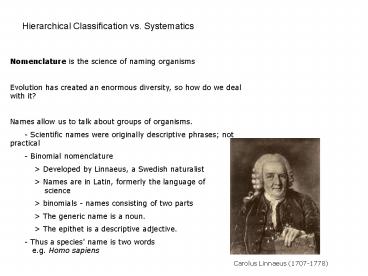Nomenclature is the science of naming organisms - PowerPoint PPT Presentation
1 / 11
Title:
Nomenclature is the science of naming organisms
Description:
Hierarchical Classification vs. Systematics Nomenclature is the science of naming organisms Evolution has created an enormous diversity, so how do we deal with it? – PowerPoint PPT presentation
Number of Views:266
Avg rating:3.0/5.0
Title: Nomenclature is the science of naming organisms
1
Hierarchical Classification vs. Systematics
Nomenclature is the science of naming organisms
Evolution has created an enormous diversity, so
how do we deal with it? Names allow us to talk
about groups of organisms. - Scientific
names were originally descriptive phrases not
practical - Binomial nomenclature
gt Developed by Linnaeus, a Swedish naturalist
gt Names are in Latin, formerly the
language of science gt
binomials - names consisting of two parts
gt The generic name is a noun. gt The
epithet is a descriptive adjective. - Thus
a species' name is two words e.g. Homo
sapiens
Carolus Linnaeus (1707-1778)
2
Taxonomy is the science of the classification
(Hierarchical) of organisms Taxonomy deals with
the naming and ordering of taxa. The Linnaean
hierarchy 1. Kingdom 2. Division
3. Class 4. Order 5. Family
6. Genus 7. Species
Evolutionary distance
3
Systematics is the science of how organisms are
related and the evidence for those
relationships Speciation -- the origin of new
species from previously existing ones
Reconstruct evolutionary history
Phylogeny
4
Hierarchical Classification
5
Systematics
6
Which pair is more closely related? A
lizard/crocodile or bird/crocodile?
7
Important Definitions
Node a branchpoint in a tree (a presumed
ancestral OTU) Branch defines the relationship
between the taxa in terms of descent and
ancestry Topology the branching patterns of the
tree Branch length (scaled trees only)
represents the number of changes that have
occurred in the branch Root the common ancestor
of all taxa Clade a group of two or more taxa or
DNA sequences that includes both their common
ancestor and all their descendents
Branch
Node
Clade
Root
8
- Look at the cladogram at the right. What
conclusions can be drawn about the relationship
between humans and chimps?
9
How to read a Cladogram
- This diagram shows a relationship between 4
relatives. These relatives share a common
ancestor at the root of the tree. - Note that this diagram is also a timeline. The
older organism is at the bottom of the tree. - Branches on the tree represent SPECIATION, the
formation of a new species. - The four descendents at the top of the tree are
DIFFERENT species. This is called SPECIATION.
10
How to read a Cladogram
- Species B and C each have characteristics that
are unique only to them. - But they also share some part of their history
with species A. This shared history is the
common ancestor
11
- A CLADE is a group of organisms that come from a
common ancestor.

